How to fix UFW status showing as inactive in Linux
UFW, also known as Uncomplex Firewall, is adopted by many Linux distributions as their firewall system. UFW is designed to make it easy for novice users to manage firewall settings through both the command line interface and the graphical user interface.
UFW firewall is a system that monitors network traffic according to set rules to protect the network from network sniffing and other attacks. If you have UFW installed on your Linux system but its status shows as inactive, there could be several reasons. In this guide, I will share how to resolve the UFW firewall inactive issue on Linux systems.
- Why UFW shows inactive status on Linux
- Why UFW is not active by default on Linux
- How to check UFW status on Linux
- How to Fix UFW Status Showing Inactive on Linux
- How to know which application needs to be passed in via UFW
- How to use UFW to identify and allow ports
- How to enable UFW for applications that require incoming traffic
- in conclusion
Why UFW shows inactive status on Linux
Some reasons why UFW is inactive are as follows:
- In many Linux distributions, UFW comes pre-installed, but by default, it is inactive.
- If you installed UFW yourself, it will be disabled by default and show inactive status.
Why UFW is not active by default on Linux
By default, UFW is disabled because it can block SSH or HTTP ports, which is very important for server communication and management. It denies all incoming traffic and allows outgoing traffic. As a server administrator, you can send requests and receive responses. However, the firewall blocks all incoming connections.
Incoming traffic is critical for SSH and HTTP communication. Without SSH, you will not be able to access the server remotely. Before enabling UFW, be sure to confirm that these critical ports are open to allow connections.
Note: I used Ubuntu 22.04 to execute the following commands, but the instructions are the same for other distributions.
How to check UFW status on Linux
In Linux, both pre-installed and manually installed UFW are disabled by default. You need to activate it.
To check the UFW status, execute the ufw status command in the terminal:
Sudoku UFW Status

You can also check the UFW status through the UFW configuration file. To access the file, use the command given below:
sudo cat/etc/ufw/ufw. conf
Read the file and check the ENABLED service. If not, it means UFW is disabled.
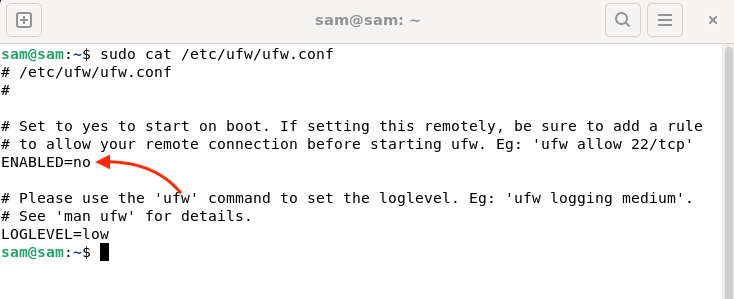
You can also launch the GUI application to check the UFW status.
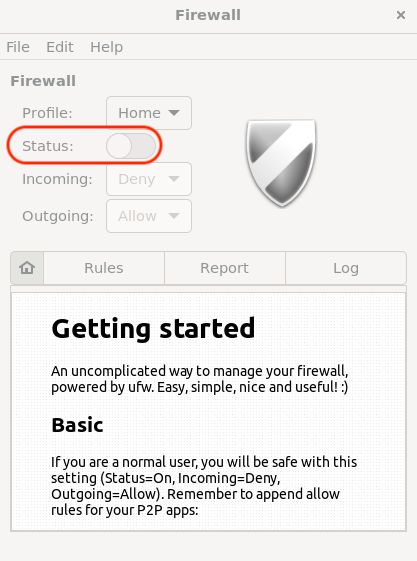
How to Fix UFW Status Showing Inactive on Linux
The inactivity of UFW can be fixed by enabling it using the command line.
Before enabling UFW, it is best to take a look at the additional rules.
sudo ufw show add

NOTE: By default, UFW denies all incoming traffic.
To enable UFW, launch a terminal and run the UFW Enable command, which will enable UFW even on boot:
sudo ufw enable

To monitor the status, run the following command again:
sudo ufw status details
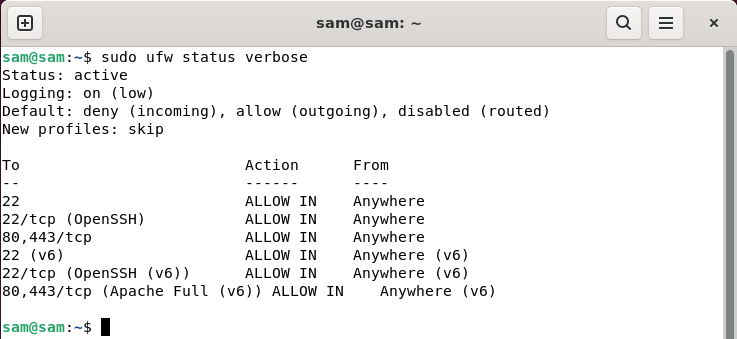
To set the status as a number, use Usage:
sudo ufw status number
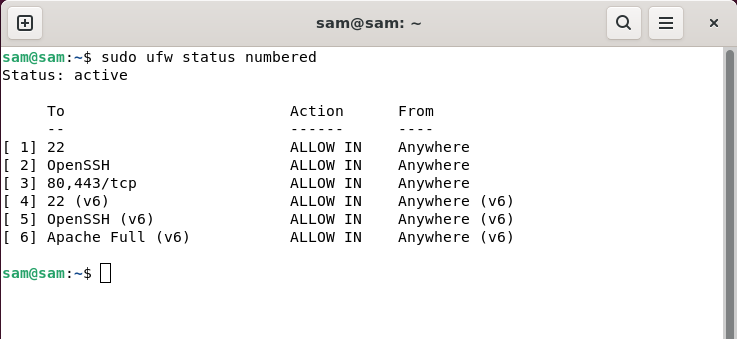
You can also enable it using UFW configuration files. Open the UFW configuration file using nano editor:
sudo nano/etc/ufw/ufw. conf
Find ENABLED, change the status from no to yes, and save the file.
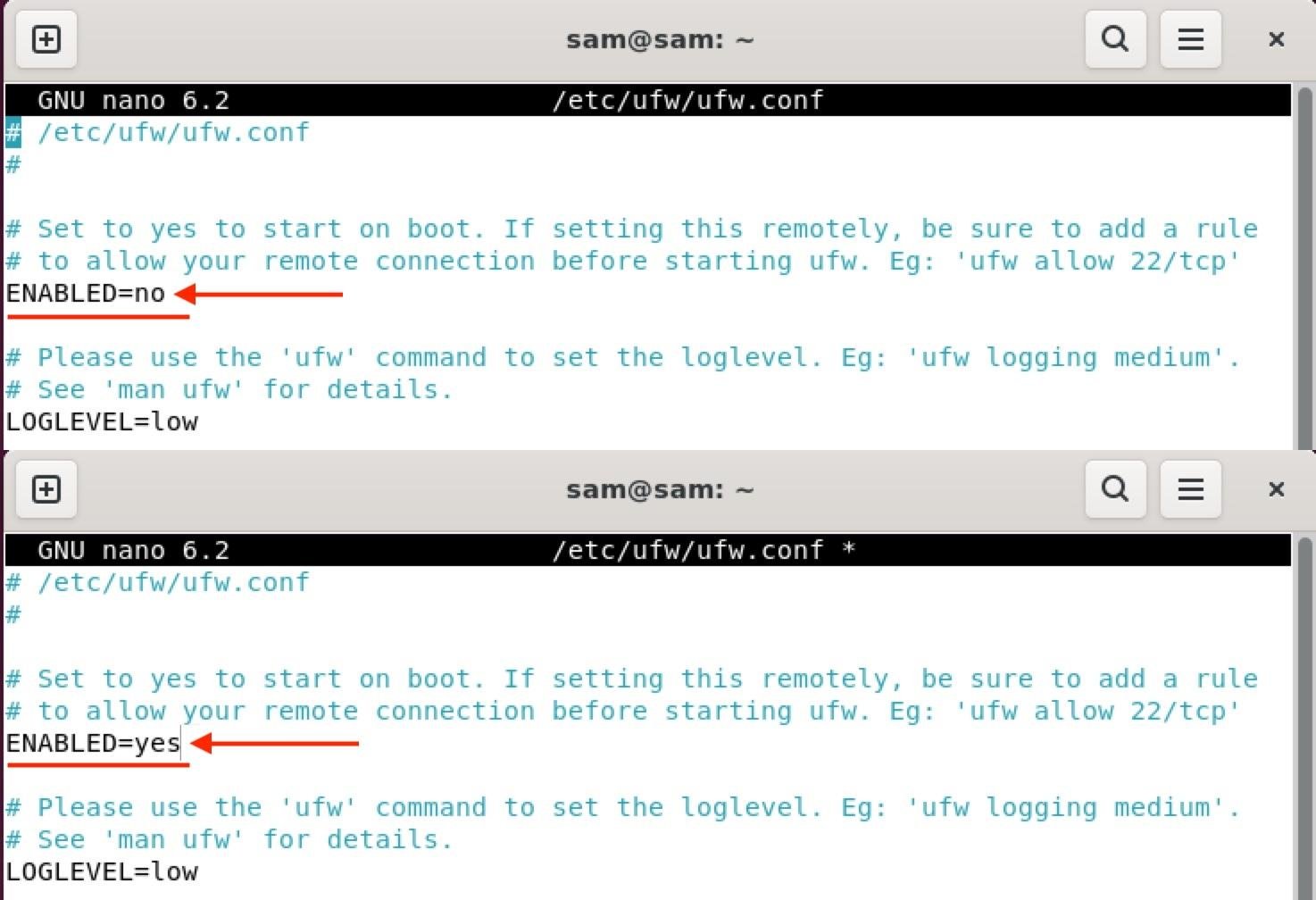
To save the file, press Ctrl X and it will prompt you to make changes, then press Y/y to save the file.
Note: The server must be restarted to enable UFW through the configuration file.
You can also enable UFW using UFW's GUI window. Launch the UFW application and toggle enable.
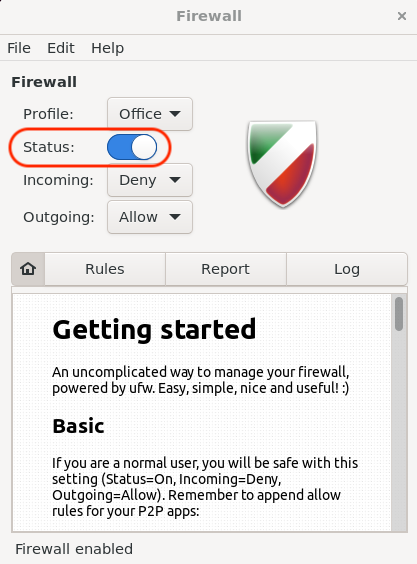
How to know which application needs to be passed in through UFW
Every port requiring incoming traffic must be allowed through UFW. SSH is crucial because if you enable UFW and don't allow the SSH port, you may lose control of the server.
To see which application must be allowed for incoming traffic, run the ufw app list command:
sudo ufw app list

Alternatively, view the UFW application configuration file:
LS/ETC/UFW/Applications.d

These are applications that need to open ports.
NOTE: Applications that require port enabled have UFW profiles.
How to use UFW to identify and allow ports
To know the port for a specific application, use the command below.
The syntax of this command is:
sudo ufw app info “”
For example, to view the SSH port name, use the following command:
sudo ufw app info “OpenSSH”

OpenSSH requires port 22 to work properly.
To check the Apache Full port, use: Purpose:
Sudoku UFW App Information "Apache Full Function"

Apache requires two ports 80 and 443 to work.
How to enable UFW for applications that require incoming traffic
When UFW is enabled, all incoming traffic will be denied. To avoid yourself being excluded from the server, it's important to add a rule to access the server via SSH before enabling UFW.
To add OpenSSH connection rules, use the following actions: Purpose:
Sudoku UFW allows 22

or usage:
sudo ufw allow “OpenSSH”

To add a rule for the Apache web server, use the following command:
sudo ufw add 80,443/tcp

Ports 80 and 443 are used for HTTP and HTTPS respectively, both of which are required by the Apache web server.
or usage:
sudo ufw allow “Apache Full”

After enabling key ports through UFW, you can use the UFW Enable command to enable UFW.
in conclusion
UFW is the default firewall for various Linux distributions. By default, it is set to inactive as it may block traffic from certain important ports such as 22, 80 or 443. To make it active, there are various programs. UFW can be enabled using commands, UFW configuration files, and through the UFW GUI. UFW disables all incoming traffic, so make sure to add SSH rules before enabling UFW.
The above is the detailed content of How to fix UFW status showing as inactive in Linux. For more information, please follow other related articles on the PHP Chinese website!

Hot AI Tools

Undresser.AI Undress
AI-powered app for creating realistic nude photos

AI Clothes Remover
Online AI tool for removing clothes from photos.

Undress AI Tool
Undress images for free

Clothoff.io
AI clothes remover

Video Face Swap
Swap faces in any video effortlessly with our completely free AI face swap tool!

Hot Article

Hot Tools

Notepad++7.3.1
Easy-to-use and free code editor

SublimeText3 Chinese version
Chinese version, very easy to use

Zend Studio 13.0.1
Powerful PHP integrated development environment

Dreamweaver CS6
Visual web development tools

SublimeText3 Mac version
God-level code editing software (SublimeText3)

Hot Topics
 What computer configuration is required for vscode
Apr 15, 2025 pm 09:48 PM
What computer configuration is required for vscode
Apr 15, 2025 pm 09:48 PM
VS Code system requirements: Operating system: Windows 10 and above, macOS 10.12 and above, Linux distribution processor: minimum 1.6 GHz, recommended 2.0 GHz and above memory: minimum 512 MB, recommended 4 GB and above storage space: minimum 250 MB, recommended 1 GB and above other requirements: stable network connection, Xorg/Wayland (Linux)
 vscode cannot install extension
Apr 15, 2025 pm 07:18 PM
vscode cannot install extension
Apr 15, 2025 pm 07:18 PM
The reasons for the installation of VS Code extensions may be: network instability, insufficient permissions, system compatibility issues, VS Code version is too old, antivirus software or firewall interference. By checking network connections, permissions, log files, updating VS Code, disabling security software, and restarting VS Code or computers, you can gradually troubleshoot and resolve issues.
 How to run java code in notepad
Apr 16, 2025 pm 07:39 PM
How to run java code in notepad
Apr 16, 2025 pm 07:39 PM
Although Notepad cannot run Java code directly, it can be achieved by using other tools: using the command line compiler (javac) to generate a bytecode file (filename.class). Use the Java interpreter (java) to interpret bytecode, execute the code, and output the result.
 What is vscode What is vscode for?
Apr 15, 2025 pm 06:45 PM
What is vscode What is vscode for?
Apr 15, 2025 pm 06:45 PM
VS Code is the full name Visual Studio Code, which is a free and open source cross-platform code editor and development environment developed by Microsoft. It supports a wide range of programming languages and provides syntax highlighting, code automatic completion, code snippets and smart prompts to improve development efficiency. Through a rich extension ecosystem, users can add extensions to specific needs and languages, such as debuggers, code formatting tools, and Git integrations. VS Code also includes an intuitive debugger that helps quickly find and resolve bugs in your code.
 Can vscode be used for mac
Apr 15, 2025 pm 07:36 PM
Can vscode be used for mac
Apr 15, 2025 pm 07:36 PM
VS Code is available on Mac. It has powerful extensions, Git integration, terminal and debugger, and also offers a wealth of setup options. However, for particularly large projects or highly professional development, VS Code may have performance or functional limitations.
 How to use VSCode
Apr 15, 2025 pm 11:21 PM
How to use VSCode
Apr 15, 2025 pm 11:21 PM
Visual Studio Code (VSCode) is a cross-platform, open source and free code editor developed by Microsoft. It is known for its lightweight, scalability and support for a wide range of programming languages. To install VSCode, please visit the official website to download and run the installer. When using VSCode, you can create new projects, edit code, debug code, navigate projects, expand VSCode, and manage settings. VSCode is available for Windows, macOS, and Linux, supports multiple programming languages and provides various extensions through Marketplace. Its advantages include lightweight, scalability, extensive language support, rich features and version
 Linux Architecture: Unveiling the 5 Basic Components
Apr 20, 2025 am 12:04 AM
Linux Architecture: Unveiling the 5 Basic Components
Apr 20, 2025 am 12:04 AM
The five basic components of the Linux system are: 1. Kernel, 2. System library, 3. System utilities, 4. Graphical user interface, 5. Applications. The kernel manages hardware resources, the system library provides precompiled functions, system utilities are used for system management, the GUI provides visual interaction, and applications use these components to implement functions.
 What is the main purpose of Linux?
Apr 16, 2025 am 12:19 AM
What is the main purpose of Linux?
Apr 16, 2025 am 12:19 AM
The main uses of Linux include: 1. Server operating system, 2. Embedded system, 3. Desktop operating system, 4. Development and testing environment. Linux excels in these areas, providing stability, security and efficient development tools.






